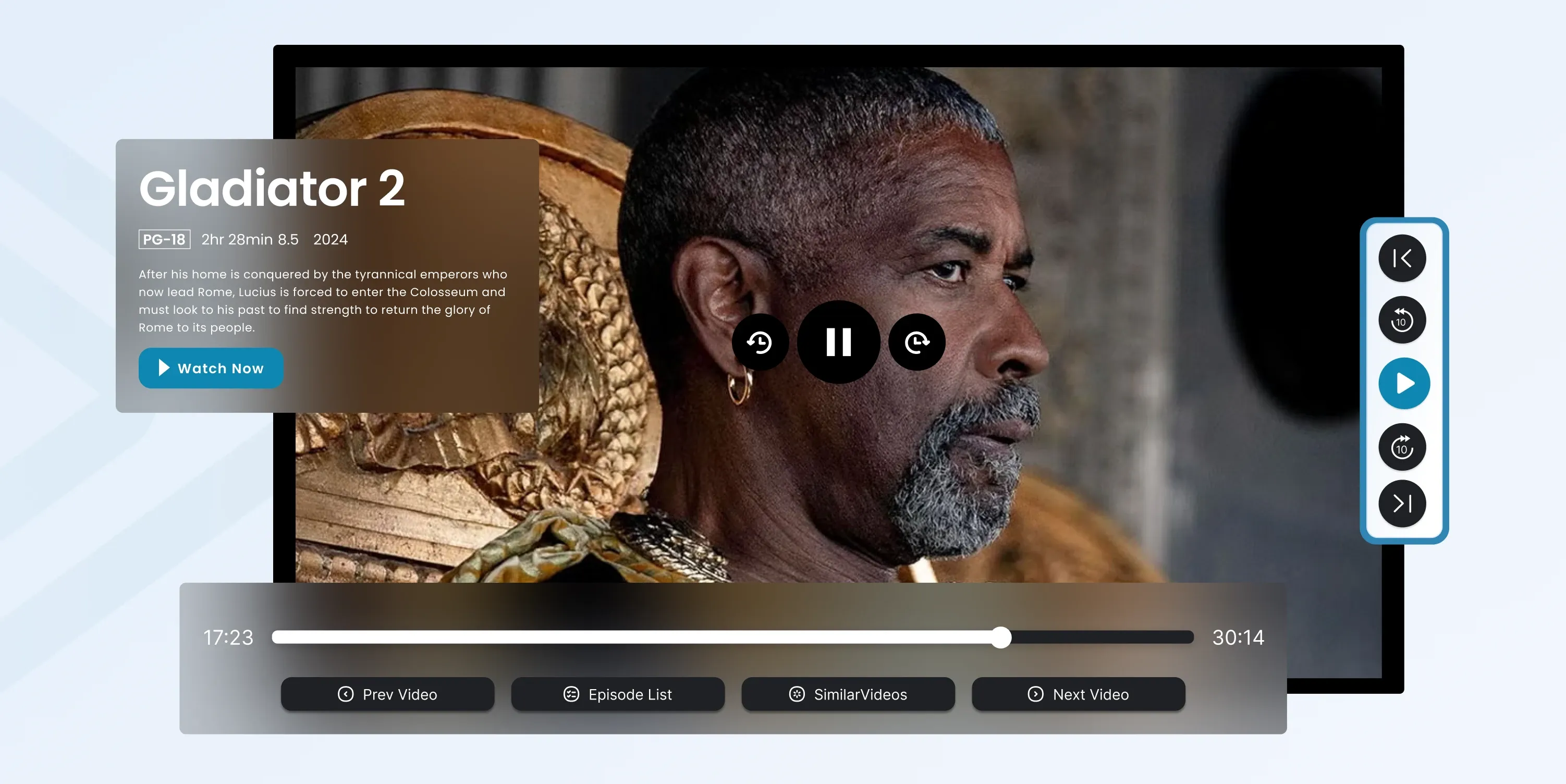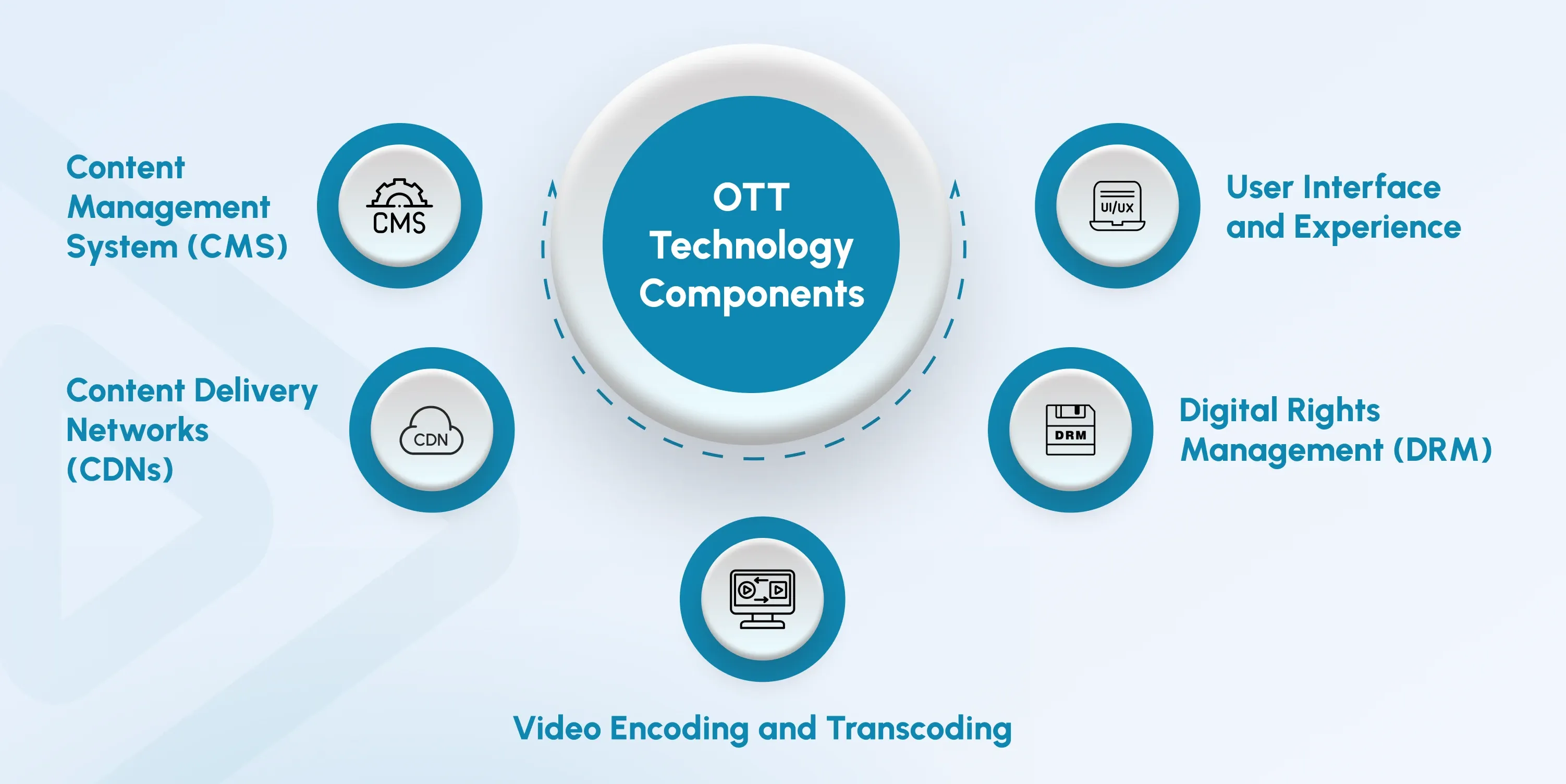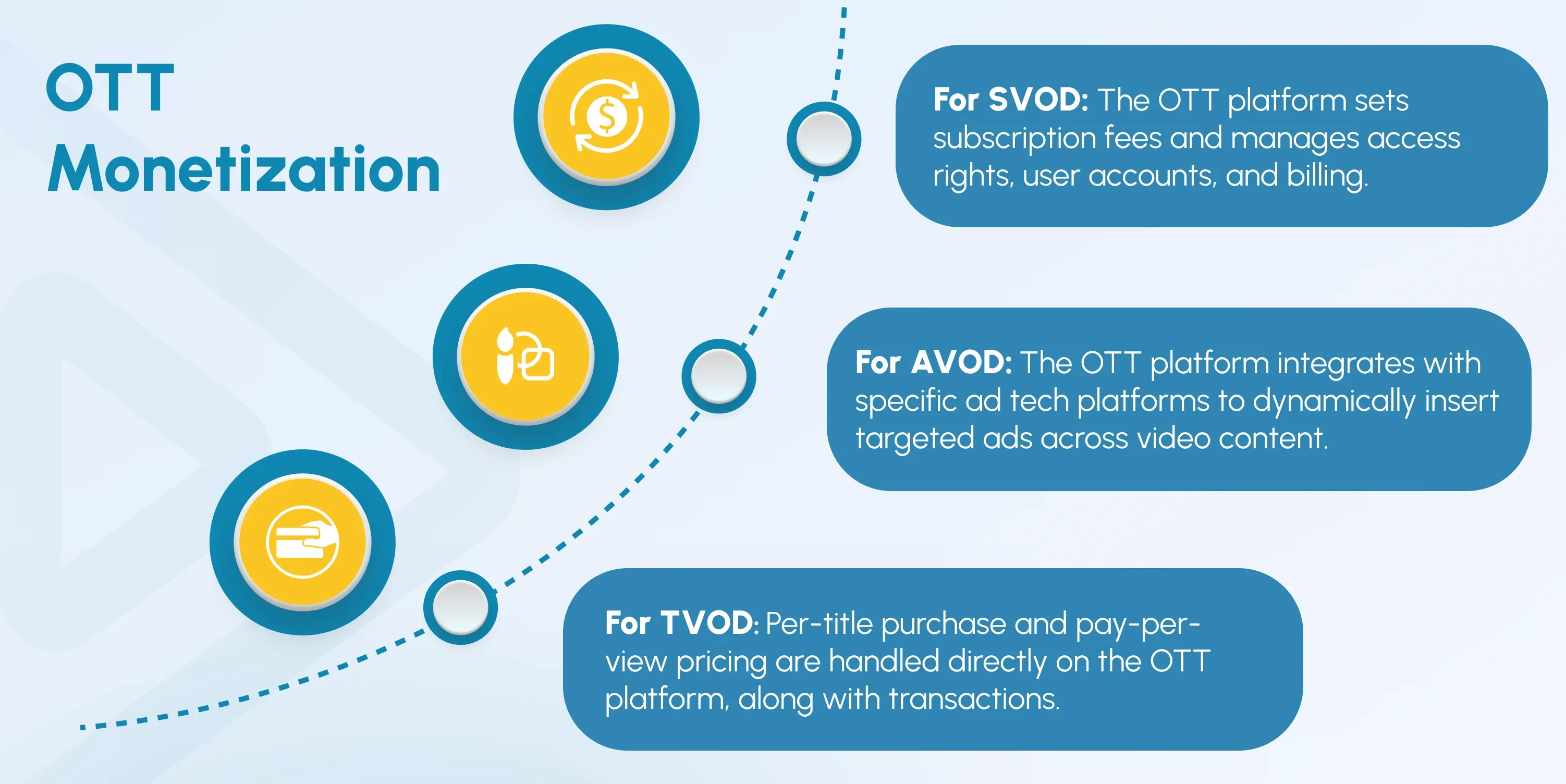
What is OTT Technology? The Definitive Guide
Over-the-top (OTT) technology has completely changed how people consume media, offering unprecedented access to entertainment, news, and information.
Unlike traditional broadcasting, OTT technologies enable streaming directly over the internet, effectively bypassing the usual distribution channels like cable and satellite.
OTT services allow consumers to watch their preferred TV shows, movies, and other media content on any internet-connected device, such as desktop computers, cellphones, tablets, gaming consoles, and smart TVs, from anywhere.
This guide uncovers the over-the-top technology, its various types, and how streaming businesses can harness its growth potential.
What is OTT Technology?
 OTT technology refers to the distribution of media content over the internet. It’s how music, movies, live events, and TV shows are delivered online without going through traditional pay-TV methods like broadcast, cable, or satellite.
OTT technology refers to the distribution of media content over the internet. It’s how music, movies, live events, and TV shows are delivered online without going through traditional pay-TV methods like broadcast, cable, or satellite.
This innovative approach enables content providers to reach a broader, more diverse audience as consumers worldwide stream content on various devices at their convenience.
In fact, Statista estimates that the number of OTT video market users will reach 4.9 billion by 2029, with the average revenue per user (ARPU) already at $80.70 in 2024.
How Does OTT Technology Work?
Over-the-top technology uses the internet’s infrastructure to deliver on-demand media tailored to a user’s preferences, location, device, and connectivity, typically through websites or apps.
With the increasing demand for convenience, flexibility, and diverse content, OTT broadcasting has become the new standard.
OTT provides greater targeting for cost-effective advertising, more freedom to reach global audiences, and real-time data insights to inform marketing strategies.
With OTT services, businesses can show relevant ads to ultra-specific audience segments based on user information, such as location, viewing habits, and preferences. This allows for more efficient and effective advertising.
Well-known video-streaming websites like YouTube and Hulu, as well as niche apps developed by independent producers, offer OTT streaming, and the content type on these platforms is referred to as OTT video.
So, what is an OTT platform, exactly?
Put simply, an OTT video platform provides users with diverse online media through cloud-based or on-premises streaming. This encompasses everything from local programs and original content to live events, movies, and TV shows.
What are The Components of OTT Technology
 OTT video technology typically consists of five primary components. Each one is described in detail below.
OTT video technology typically consists of five primary components. Each one is described in detail below.
1. Content Management System (CMS)
A CMS is a software solution that stores, organizes, and manages digital content. It allows for efficient metadata tagging, categorization, and content retrieval. This streamlines and enhances content discovery and access for OTT platform users.
2. Content Delivery Networks (CDNs)
CDNs are geographically distributed server networks vital for optimizing content delivery on over-the-top (OTT) platforms.
By caching content close to the end-user, CDNs reduce latency and buffering, thereby improving streaming quality. This enhances customer satisfaction by ensuring that viewers can experience uninterrupted playback regardless of their location.
3. Video Encoding and Transcoding
Video encoding compresses raw or original video content to reduce file size without affecting quality. Through transcoding, encoded file attributes like format, bitrate, codec, or resolution are altered into digital forms for efficient playback over the internet.
These processes are an essential component of OTT video technology. They optimize content for adaptive bitrate streaming, which ensures a flawless viewing experience by adjusting video quality based on the user’s device and internet speed.
Read more about transcoding vs. encoding here.
4. Digital Rights Management (DRM)
Digital rights management prevents media from being copied or used without permission by encrypting content and providing authorized users with decryption keys.
This enables OTT platforms to manage content licensing agreements, access restrictions, and different OTT monetization strategies. A DRM system also protects content for secure distribution across various devices.
5. User Interface and Experience
A top OTT provider offers end-users an engaging experience with a user interface (UI) that’s intuitive and personalized. It’s a crucial aspect of any OTT platform, enabling users to browse, search, and play content on their preferred device through a website or mobile app.
What are OTT devices in this context? OTT devices refer to internet-enabled devices like computers, smart TVs, gaming consoles, tablets, smartphones, and even Internet of Things (IoT) devices that can stream content.
Advanced Over-the-Top Technology
OTT video technologies are continuously evolving, enhancing both the quality and experience of digital media consumption. Below, we explore some of the latest advancements.
AI-Powered Insights and Hyper-Personalization
Like many other spheres, artificial intelligence (AI) has had a major impact on the over-the-top industry. AI and machine learning (ML) developments have revolutionized OTT services with:
- Highly contextualized customization based on consumers’ behavioral data like search terms, viewing history, ratings, and other real-time information.
- Enhanced content delivery and more granular search results through recommender systems using content-based, collaborative filtering-based, and knowledge-based approaches.
- Detailed data analytics on viewer behavior, content performance, and ad campaign effectiveness for optimized marketing efforts.
Multi-Platform Support
OTT solutions largely rely on data visibility. With cross-device compatibility, anyone with any device can instantly view content, allowing seamless and enjoyable viewing anytime, anywhere.
Cloud-Based Infrastructures
The full form of OTT video technology uses cloud-based infrastructure to reliably store, organize, and distribute content to users worldwide. This allows businesses to scale their operations to meet the growing demand for their services.
Cloud-based technologies also enable flexible content delivery with the ability to modify server capacity depending on demand, reducing costs without compromising speed.
OTT Monetization
Content providers can monetize their streams with OTT technology. Here are the main monetization models.
1. Subscription Video on Demand (SVOD)
With SVOD, users can access an online video library for a predefined monthly or annual charge.
Subscribers can enjoy curated content for a fixed fee, providing OTT platform owners with a steady revenue stream.
Disney+, Netflix, and Amazon Prime Video are all SVOD-based services.
2. Advertising-Based Video on Demand (AVOD)
AVOD services are supported by advertisements, allowing users to access online content at no cost in exchange for watching an ad. This enables OTT platforms to have a wider reach.
A few examples are Crackle, YouTube, and Tubi.
With the AVOD business model, content producers make most of their income from advertising.
3. Transactional Video on Demand (TVOD)
The TVOD model lets users buy or rent premium content once-off. Given that viewers are only charged for an individual piece of content rather than the entire library, TVOD is commonly referred to as pay-per-view (PPV), pay-per-download (PPD), or electronic sell-through (EST).
One example is paying to view a big sports event, such as a boxing match, on Sky Box Office.
TVOD is an excellent choice for a business looking to rent out or sell a single video feature. Movie premieres, once-off athletic events, instructional films, and live-streaming events are all instances of content that can greatly benefit from this format.
Google Play Movies, Vudu, and iTunes are some popular TVOD-based services.
4. Hybrid Video On Demand (HVOD)
An HVOD model combines different AVOD, SVOD, and TVOD monetization strategies to maximize revenue and expand audience reach. The three most common OTT broadcasting hybrid models are:
- AVOD + SVOD: This approach offers both subscription-based content and no-charge ad-based viewing, often accompanied by free samples of premium content to attract new subscribers.
- SVOD + TVOD: This hybrid model is designed to meet the needs of a wider audience. An OTT provider can serve both long-term subscribers and one-time buyers by accepting both types of payments.
- Multi-Tiered Model: This approach leverages AVOD, SVOD, and TVOD to offer a combination of subscription-based, ad-supported, and pay-per-view content. This allows an OTT platform to diversify its revenue opportunities by catering to a wider audience with different preferences.
Peacock, YouTube, and Samsung TV Plus all use hybrid OTT monetization methods.
How Does OTT Monetization Work?
 OTT monetization works according to an OTT provider’s available monetization models (or a combination) as follows:
OTT monetization works according to an OTT provider’s available monetization models (or a combination) as follows:
- For SVOD: The OTT platform sets subscription fees and manages access rights, user accounts, and billing.
- For AVOD: The OTT platform integrates with specific ad tech platforms to dynamically insert targeted ads across video content.
- For TVOD: Per-title purchase and pay-per-view pricing are handled directly on the OTT platform, along with transactions.
With the right monetization model, you can reach your target audience and maximise your revenue potential.
What are The Benefits of OTT Platform?
1. Broadcast Any Type of Ad Content
When it comes to streaming services, television networks often have limitations in terms of the number of channels and advertising opportunities available. As a result, they may not be able to broadcast all types of ad content.
However, OTT platform technology allows you to run any kind of advertising content for your business. Rest assured that your ads will reach a diverse range of demographics relevant to your marketing needs, ensuring maximum visibility.
2. Better Control Over Your Campaigns
Having more control over your advertising efforts is another advantage of using OTT video technology. Unlike traditional media, OTT platforms offer in-depth data analytics, allowing you to pause, resume, and adjust your ad strategies in real-time.
With this level of authority, you can effortlessly transition between platforms and optimize your campaigns for improved performance and return on investment (ROI).
3. Increased Audience Engagement
OTT platforms enable you to greatly enhance audience engagement through features like personalized recommendations, social media integration, and interactive advertisements.
By offering content tailored to individual preferences, your business can leverage highly targeted OTT commercials for maximum ROI. It’s something conventional media channels lack.
4. Improved Targeting Abilities
The long-term success of any brand depends on engaging its target audience at the appropriate moment. OTT ads ensure that your efforts reach the correct individuals depending on age, gender, viewing patterns, and geography.
With AI-powered algorithms and data-driven insights, OTT technology allows you to implement more impactful and relevant ad campaigns, optimized for cost-effectiveness and efficiency.
Choose inoRain for Your OTT Business Needs
inoRain provides scalable OTT solutions focused on high-quality and customization.
No matter the size of your streaming business, you can use our end-to-end OTT platform to transform your business into a revenue-generating streaming machine.
Get Your White-Label OTT Platform Today
The Future of OTT Technologies
As technology continues to evolve, several trends are shaping the future of over-the-top technology, including:
1. AI and Machine Learning
Ongoing developments in machine learning and artificial intelligence are poised to revolutionize OTT video technology. Various AI applications can greatly enhance content discovery and viewer engagement. These include automated content tagging, enhanced content recommendation engines, and robust predictive analytics.
2. 5G and Edge Computing
New developments in edge computing and the introduction of 5G networks will enable lower latency, reliability, and faster streaming. OTT companies will need these technologies to offer immersive experiences like VR and AR content.
3. Blockchain Technology
Blockchain technology is currently being explored as a viable option for improved OTT content protection. It enables secure storage, classification, and distribution of digital content, helping to reduce piracy and protect intellectual property rights.
Conclusion
With AI-driven customization and varying monetization models, OTT platforms are fast becoming an integral part of today’s corporate landscape.
Streaming businesses that implement over-the-top technology can benefit in many ways, like reaching a wider audience, increasing engagement, and getting more revenue opportunities. OTT is a crucial component of any modern digital strategy.
FAQs
What is OTT?
OTT (Over-the-Top) is a modern streaming technology that refers to the delivery of media content, such as video, audio, and other digital services, directly to consumers via the internet. It bypasses traditional distribution channels like cable, satellite, or broadcast television.
OTT allows users to access on-demand content through various internet-connected devices, including smartphones, tablets, smart TVs, and computers.
What is the difference between OTT and IPTV?
IPTV (Internet Protocol Television) transmits TV programming over private IP networks, usually maintained by telecom operators or ISPs. Conversely, OTT platform technology provides video content directly to consumers through the internet, therefore bypassing traditional TV networks and cable providers.
What is OTT ad tech?
OTT ad tech refers to the technology and systems used to advertise on OTT platforms and across streaming services. OTT ad tech encompasses ad targeting, ad performance measurement, and ad insertion.
What is the biggest OTT platform?
The biggest OTT platform is currently Netflix. That said, major contenders include Disney+ and Amazon Prime Video.
Co-founder / CTO
Armen is the CTO and Co-Founder of inoRain OTT and Co-Founder of HotelSmarters, specializing in advanced streaming technologies, OTT strategy, and interactive TV systems. He builds scalable end-to-end video delivery solutions and drives technical innovation across hospitality and streaming platforms, bridging complex engineering with practical business impact.

How to Develop a Video Streaming App: Best Practices
Learn the basics of developing a modern video streaming app. This guide covers key best practices to help you build the right way from the start.

How to Make a Short Video App (2026 Complete Guide)
Learn how to build a short video app in 2026. Explore micro-drama trends, key features, monetization models, and step-by-step development insights.

OTT Advertising: Types, Best Practices, and Strategies
Over-the-top (OTT) advertising has transformed how brands connect with consumers.

